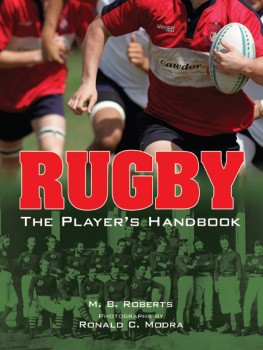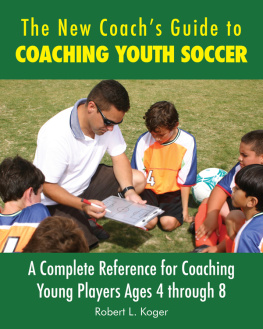

SOCCER
THE PLAYERS HANDBOOK
M. B. ROBERTS
PHOTOGRAPHS BY RONALD C. MODRA

STERLING and the distinctive Sterling logo are registered trademarks of Sterling Publishing Co., Inc.
Library of Congress Cataloging-in-Publication Data
Roberts, M. B. (Mary Beth)
Soccer : the players handbook / M.B. Roberts ; photographs by Ronald C. Modra.
p. cm.
Includes bibliographical references and index.
ISBN 978-1-4027-5872-0 (pb-trade pbk. : alk. paper)
1. SoccerHandbooks, manuals, etc. I. Modra, Ronald C. pht II. Title.
GV943.R55 2010
796.334dc22
2009013682
10 9 8 7 6 5 4 3 2 1
Published by Sterling Publishing Co., Inc.
387 Park Avenue South, New York, NY 10016
Text 2010 by M. B. Roberts
Photos 2010 by Ronald C. Modra
Photography by Ronald C. Modra
All rights reserved
Sterling ISBN 978-1-4027-5872-0
Sterling eBook ISBN: 978-1-4027-8354-8
For information about custom editions, special sales, and premium and corporate purchases, please contact Sterling Special Sales Department at 800-805-5489 or specialsales@sterlingpublishing.com.
CONTENTS
by Stephen H. Baumann, National Soccer Hall of Fame
1: KICKOFF
The Ins and Outs of the Global Game
2: THE STORY OF SOCCER
Who Kicked It First... and Where and When
3: THE RIGHT STUFF
Getting Equipped for Soccer
4: JUST FOR KICKS
How to Play the Beautiful Game
5: TRAINING FOR SOCCER
Workouts and Tips for Getting Game-Ready
6: PRACTICE, PRACTICE, PRACTICE
How to Get Fast, Get Focused, and Get Good Feet
7: HEY COACH
How to Turn Kids into Players
8: MAKE IT OFFICIAL
How to Keep Score, Keep It Safe, and Keep the Match Moving
Soccer is the most popular sport in the world. All over the globe, people are attached to this game in deep and passionate cultural ways.
In the United States, even though the professional game hasnt been completely embraced by most sports fans, soccer is in the mainstream. Millions of kids are playing soccer every weekend all over the country.
People love playing the sport, they love being involved in the sport, and the game gives much to them. Thats why the soccer community is growing at such a phenomenal rate.
Today, soccer is front and center in the lives of many families. Just look in the media. Ads on TV and in magazines show soccer moms loading their kids in the car to go to soccer practice. Its part of the culture, whether you were born here or you moved here from another country and brought your love and knowledge of soccer with you. There is a truly vibrant soccer scene out there. But it took us a while to get here.
In the late sixties, high-school soccer players were still in the minority, but I grew up in Westport, Connecticut, where soccer was a big part of the community. Staples High School, where I played varsity soccer, was legendary for winning annual state championships and sending dozens of players to top soccer colleges and later to the North American Soccer League (NASL).
With the establishment of the NASL, new hope emerged for the growth of soccer here in America. For me in 1974, a senior on the soccer team at the University of Pennsylvania, this was incredibly exciting because I now had the opportunity to play pro soccer. I played for the Miami Toros for three years and in 1976 even battled against Pele at Yankee Stadium.
Even though the NASL struggled and eventually disbanded in 1984, the spark that ignited a new era in the development of soccer in the United States was lit. As I moved on to become a high-school coach and later a college coach, I watched something incredible happen. Youth clubs were popping up everywhere. Soon, there wasnt a field in America where kids werent playing soccer on Saturdays and Sundays.
The NASL was the engine behind this initial growth.
But of course there are many reasons for the explosion of the youth game in this country. First, soccer offers lots of opportunities for children to run, jump, twist, create, and express, matching perfectly the desires of every six-year-old. While real soccer requires large fields, youth soccer can thrive on smaller patches of grass that turn baseball outfields into hives of goal-scoring celebrations. Soccer does not require a lot of equipment, and it provides lots of exercise in a safe environment. And perhaps most importantly of all, its gender-neutral and encourages the participation of both sexes. The enactment of Title IX was a huge development for sports in America, and soccer was often the perfect solution to parity for boys and girls in sports. The timing was right.
Playing sportsany sportoffers the opportunity for players to develop qualities that will help them as they strive for excellence in their lives. Perseverance. Commitment. Leadership. But soccer may be one of the best sports where an individual can truly grow and develop. This is a sport that demands its players take on a lot of responsibility for what happens in the game. There are no time-outs. The game runs uninterrupted. Much responsibility for team success and excellence rests with each individual player.
Even so, its difficult to score a goal. It requires everyone working together. Thats what sets our game apart. Its the ultimate team sport. Perhaps the most important thing to remember is that kids love to play this game because it is so free-flowing and fosters much creativity and expression. During the match itself, coaches actually have very little influence on the players. Its important to let kids experience the joy and heartbreak that comes when they are responsible for the outcome of the game. Coaches (and parents!) need to resist the urge to impose too much structure during practice and to give too many instructions during the game.
Kids are inherently creative. They want to be active and expressive. They want to enjoy and revel in their time on the field. Our job is to make sure that when our coaching experience is over, they still have that same passion. Lets make sure that when they leave our team and they move on to the next level, their love of the game is flourishing.
At the National Soccer Hall of Fame and Museum, our mission is to energize participation, inspire excellence, and celebrate achievement in the worlds most popular sport. Were hopeful that the experiences we facilitate compel people to imagine and engage in a lifetime of distinction. Soccer provides a wonderful platform to emphasize those values and qualities that are so important to a vibrant and nurturing community. I am hopeful that this wonderful book will inspire you to create soccer experiences that contribute to the development of your players and your community. Now theres a goal!
Stephen H. Baumann
President
National Soccer Hall of Fame and Museum
This book could not have happened without the expertise and enthusiasm of Cindy and Doug Taylor and their awesome and knowledgeable soccer-playing sons, Shaun and Ryan. Thanks for all the ideas, for fact-checking, and for being our safety net. A special thank-you to Coach Trip Ellis for organizing and leading the demonstrations performed by FC Richmond players and for contributing many valuable resources for this book.
Thanks to all the players (and prodding parents) who contributed quotes for the book, especially Tori Leech, the Gipsons of Ijamsville, the young King sisters in Brazil, and the Baumhower brood in Alabama.
Next page
















